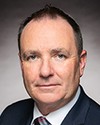Good evening. Thank you, Mr. Chair and committee members, for inviting us to appear before you today.
I am Dr. Cyd Courchesne, the chief medical officer and director general of health professionals for Veterans Affairs Canada. I'm also a 30-year veteran of the Canadian Armed Forces, having served from 1984 to 2014 and retired at the rank of Captain (Navy). I'm joined today by my colleague Trudie MacKinnon, director general of centralized operations, also a veteran, who served six years with the reserves.
As both veterans and leaders at Veterans Affairs Canada, we are pleased to appear today for this study on the experience of women veterans.
My career started in Cold Lake, Alberta, providing care to service members and their families. I looked after fighter pilots and ground crew—both male and female—and delivered their babies. I can tell you that it was the most exciting and rewarding posting of my career and is probably the reason I stayed in the forces for 30 years.
I worked in flight safety. I worked as wing surgeon in Trenton and at the Canadian Forces Environmental Medicine Establishment in Toronto. I served as the Royal Canadian Air Force surgeon and eventually as a senior leader with the CF health services headquarters. I deployed to Djibouti, Africa on a mission with the UN High Commission for Refugees. I accompanied many fighter squadrons on exercises to the Arctic and the U.S. and participated in the domestic Operation Assistance during the Manitoba floods of 1997.
After eight years at Veterans Affairs Canada, or VAC, I can say that the department is committed to ensuring that women veterans have access to supports, programs and services that meet their unique needs.
According to the 2021 census, nearly one in six veterans is a woman. We know that women veterans have distinct experiences in the military and have unique needs after their service. Female veterans are more likely to experience challenges in all seven domains of well-being, including difficulties in transitioning to civilian life, different reproductive and sexual health challenges and needs, barriers to accessing services, and reluctance to identify as a veteran.
The Office of Women and LGBTQ2 Veterans was created in July 2019 to work horizontally within the department, and with partners and veteran stakeholder groups, to help identify systemic barriers impacting women veterans and contributing to inequitable outcomes.
The office is also the departmental functional lead for GBA+. We now have a GBA+ strategy that identifies key actions and a GBA+ policy that sets clear roles and responsibilities within the department.
We have also strengthened our data collection, leveraging national survey data and qualitative storytelling of lived experiences like military sexual trauma, the LGBT purge, women's health issues and so on.
Following the first Women Veterans Forum in 2019, the minister committed to regular conversations with women veterans, resulting in a virtual series in 2020 and the recent 2SLGBTQI+ Women and Veterans Forum, held in February 2023.
Veterans Affairs Canada is committed to taking action and developing a departmental action plan to achieve equity and inclusion goals for women veterans and other under-represented or marginalized groups, to create a culture of equity and inclusion with measurable goals and outcomes.
The minister created six advisory groups on families, policy, mental health, service excellence and transition, care and support, and commemoration. These groups are made up of stakeholders, and 40% of those are women.
That's not to mention the establishment of the Atlas Institute for Veterans and Families, which is doing a lot of excellent work in this field. We've already heard from them. I will let them speak to their successes and their work, as they mentioned in their opening remarks.
In addition to enhanced awareness and understanding of the specific needs of subpopulations, targeted engagement with women and 2SLGBTQI+ veterans, and concerted efforts to integrate the use of disaggregated data, we've made advancements in the following areas: a veteran identifier in the 2021 census, in addition to a gender identity marker; a VAC women veterans research plan; the veteran family well-being fund, with targeted funding to support women and other marginalized groups; the implementation of sex and gender equity research principles in VAC-sponsored research; fairness in disability benefit adjudication, with a dedicated unit focused on women veterans' claims; improvements to the table of disabilities and the entitlement eligibility guidelines; and inclusive commemorative activities and products.
Also, in partnership with the sexual misconduct support resource centre, we're developing a military sexual trauma peer support program, and more recently—


